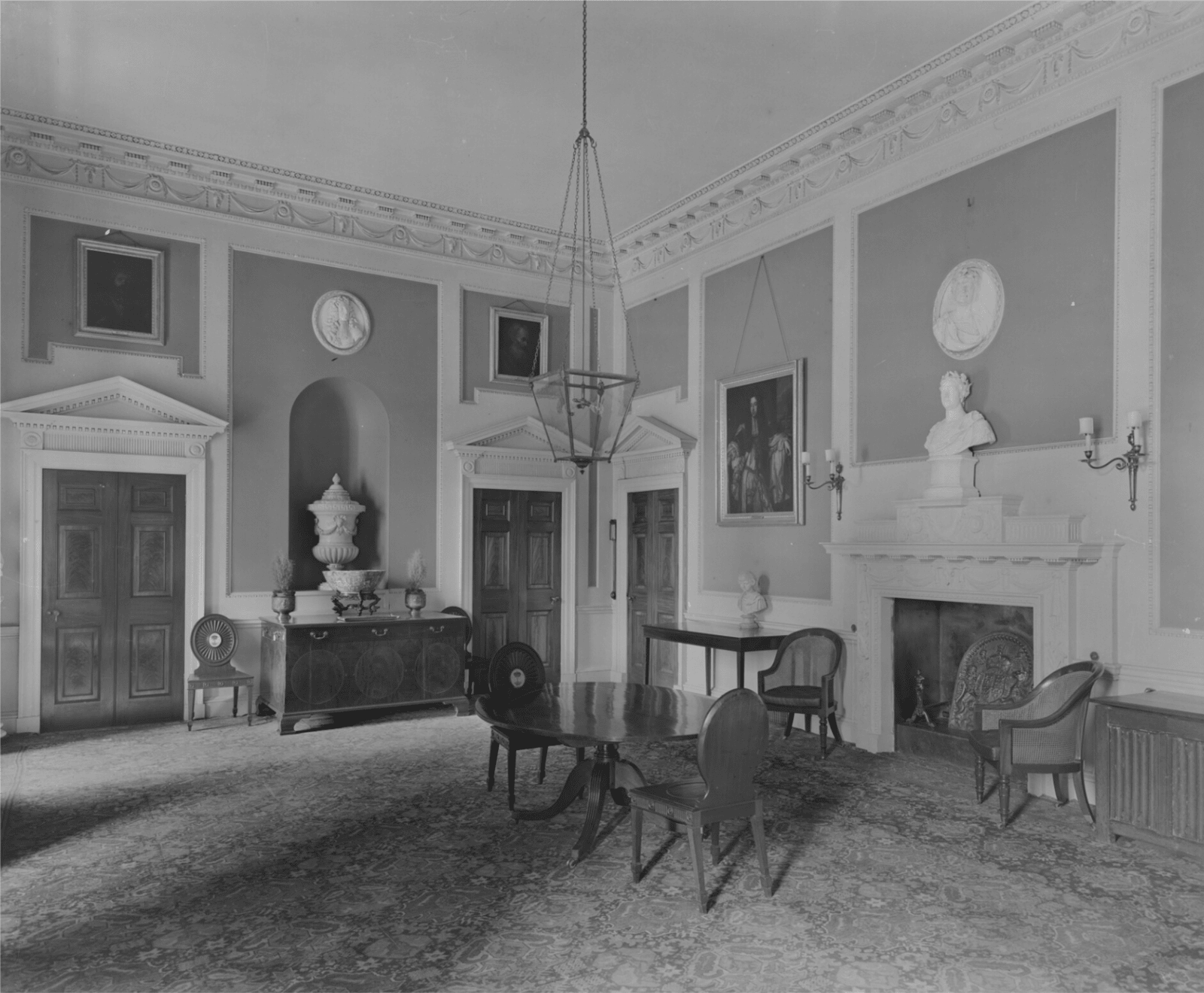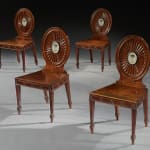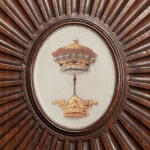A SET OF FOUR GEORGE III MAHOGANY HALL CHAIRS ATTRIBUTED TO MAYHEW AND INCE
W: 52.7 cm
D: 48.3 cm
Further images
Provenance
Supplied to George Brodrick, 4th Viscount Midleton (d.1836) for Peper Harow, Surrey, and by descent
Lady Moyra Loyd, née Brodrick, daughter of the 1st Earl of Midleton
The Property of a Family Trust; Christie’s London, 21 April 1994, lots 304-306
With Jonathan Harris, London
Christie’s, New York, 15 April 2005, lots 220 (USD 60,000) and 221 (USD 57,600)
Christie’s, 13 December 2018, lots 91-2 (GBP 50,000; 56,250)
Literature
H. A. Tipping, 'Peper Harow, Surrey', Country Life, 26 December 1925, p. 1005, fig. 5 (illustrated in situ in the Hall)
H. A. Tipping, English Homes, Period VI, vol. I, p. 279, fig. 439 (illustrated in situ in the Hall)
C. Hussey, English Country Houses, Mid-Georgian 1760-1800 (London 1956), p. 111, fig. 205 (illustrated in situ in the Hall)
J. Harris, Sir William Chambers, London 1970, pl. 88 (illustrated in situ in the Hall)
H. Roberts and C. Cator, Industry and Ingenuity: The Partnership of William Ince and John Mayhew (London 2022), pp.253-4, fig. 300
These hall chairs, painted with the Midleton family crest below a Viscount’s coronet, were originally located at Peper Harow, the seat of the Viscounts Midleton in Surrey. An 1851 inventory of the house by Farebrother, Clark & Lye of London recorded them as: “A Pair of Mahogany Hall Chairs with crest emblazoned on panels” in the “Inner Hall,” and “6 Mahogany Hall Chairs with Crest emblazoned on white panels” in the “Entrance Hall and Portico.” Photographs of part of the set were featured in Country Life magazine in 1925.1
George Brodrick, 4th Viscount Midleton (1754-1836), inherited the title and estates in England and Ireland upon his father’s death in 1765 when he was just eleven years old. Only five months before, his father, the 3rd Viscount (1730-65), had commissioned esteemed architect William Chambers (1723-96) - from 1769–82 Comptroller of the King’s Works - to design a new house at Peper Harow. In George’s minority construction continued under the supervision of his mother, Albinia, and was completed after he came of age in 1775, with the furnishing finalized by 1777 under Chambers’s ongoing leadership.
Chambers, a self-proclaimed ‘Very pretty Connoisseur in furniture’, naturally turned to his preferred cabinet-makers, the renowned London firm of John Mayhew (1736-1811) and William Ince (1737-1834), who were leading advocates of neo-classicism. The Peper Harow chairs can be compared to a nearly identical set of eight painted chairs at Broadlands, Hampshire.Though no specific bills survive for the Broadlands furniture, these chairs are part of a broader collection attributed to Mayhew and Ince and were listed in a household inventory of 1786.2
Both sets share distinctive features, including roundels and fluted seat rails, and the model was clearly highly fashionable, with a further set photographed by Country Life at Castle Howard, Yorkshire and another supplied to Robert Myddelton-Biddulph for his London house in Albermarle Street, later descending to Chirk Castle, Wales.3 No bills amongst the Peper Harow papers listing the present chairs survive. Although, Mayhew and Ince were likely paid by Chambers himself, who acted as paymaster on the project. The firm appears frequently in his’ Drummonds account, the two often collaborating together on project, during the late 1760s for example for the refurbishment of Blenheim Palace for the 4th Duke of Marlborough.4
Notably, Mayhew is recorded in Albinia’s ‘My Children’s Acc’t’ in February 1767 when he supplied a bed, so the firm was known to the family from an early date and would have likely been approved by the family in Chambers’ proposal.
The carving on the Peper Harow chairs is almost certainly the work of Sefferin Alken (fl. 1744-83), a specialist carver who mainted close relationships with London’s top cabinet-making firms. Having worked extensively with Chambers on notable projects such as the medal cabinet for the 1st Earl of Charlemont and various pieces for Blenheim Palace and Woburn Abbey, he was likely requested by Chambers who exercised very close supervision in the matter of furnishing and decorative arts.5 Alken was also doubtless known to Mayhew & Ince, having for example previously worked for John Cobb at Croome Court, where the pair had also supplied furniture.6
1 H. A. Tipping, ‘Peper Harow, Surrey’, Country Life, 26 December 1925, p. 1005, fig. 5; H. A. Tipping, English Homes, Period VI, Vol. I, p. 279, fig. 439; C. Hussey, English Country Houses, ‘Mid-Georgian 1760-1800’ (London, 1956), p. 111, fig. 205; J. Harris, Sir William Chambers (London, 1970), pl. 88
2 H. Roberts, ‘The Ince and Mayhew Connection: Furniture at Broadlands, Hampshire – I’, Country Life, 29 January 1981, pp. 288-9, fig. 6
3 H. Avray Tipping, English Homes, Period IV, Vol. II (London, 1927), p. 35; c.f. ‘the Myddelton Family, Chirk Castle, Christie’s house sale, 21 June 2004, lot 54, and later Christie’s, London, 10 May 2006, lots 90-1
4 J. Harris, Sir William Chambers: Knight of the Polar Star (London, 1970), pp. 175-6, 199
5 G. Beard, C. Gilbert, Dictionary of English Furniture Makers 1660 - 1840 (Leeds, 1986), p. 59
6 Ibid., p. 8; c.f. also Nicholas Goodison, William Chamber’s Furniture Designs’, Furniture History (1990), Vol. 26, pp. 81-3





